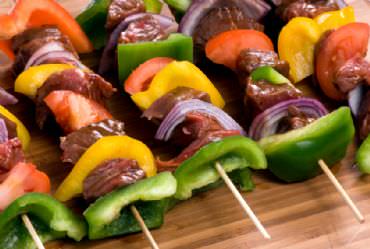
Tanya earned her dietetics degree, completed a dietetic internship and served as a clinical dietitian in several Cincinnati hospitals. With more than 20 years of nutrition education experience, she is also a member of the American Association of Diabetes Educators.![]()
Read More of 's Blogs:

Fiber: Perhaps Not as Simple as You Thought
Since the early 1950's when the term was first coined, dietary fiber has been known as a type of carbohydrate from plant foods that is not digested or absorbed. They are talked about many times based on their two different types, soluble and insoluble. Soluble fiber touted for its blood cholesterol lowering benefits and ease to acquire from foods such as oats, beans, lentils, citrus fruits, and carrots. Insoluble fiber recommended for its benefits for the digestive system and healthy food sources such as bran, whole grain products, fruit, and vegetables.
Food manufacturers have begun adding fiber to foods that were previously fiber free. (Learn more about this "stealth fiber.") Foods such as yogurt, ice cream, or drinks with isolated fibers confuse the issue for many consumers. Since many of these isolated fibers can affect the gastrointestinal system and do not contain health protective benefits, it is important to know about new classifications of fiber and why these new additives are permitted.
In 2001, a Panel on the Definition of Dietary Fiber (an Institutes of Medicine panel) responded to an FDA request to formally define dietary fiber. The IOM referred to recommendations and work done by the AACC (American Association of Cereal Chemists) and developed definitions that were presented to the FDA. New definitions focus on diversity of non-digested carbohydrates in the food supply. They broaden the definition from just plants to include carbohydrates contributed by animal foods as well. They also open the door to manufactured fibers as well. So what does this mean to you when you are trying to monitor your fiber intake?
Posted 8/30/2010 6:07:59 AM By: : 73 comments 31,600 views

Which is Better: Canned or Frozen Vegetables?
Fresh fruits and vegetables serve as a nutritional powerhouse for most healthy diets. Loaded with vitamins, minerals, fiber and phytochemicals, they also help protect against disease. Sure there are small health risks from pesticides, but those are easily dealt with by selecting organically certified produce. While fresh produce can be more costly and make them challenging for a tight budget, there are tips to make them more affordable. Fresh produce can require more time to peel, slice, dice, and chop, but pre-cut, pre-washed, and ready to serve options save time for a slightly higher cost.
When fresh vegetables are not available, practical, or economically feasible, canned and frozen provide another alternative. Both are convenient and readily available but which is better nutritionally?
Posted 8/26/2010 11:05:08 AM By: : 88 comments 263,582 views

Don't Be a Dry Sponge
Marketing can be a wonderful thing. It can also cause people to venture away from the truth in favor of false promises. The goal of marketing is to present products, goods, or services in such a way as to be desirable. The marketing process is most effective when a well-defined user or buyer's attention has been adequately captured to the point that new concepts or propositions are enticing. This process is most valuable when doubt about the alternatives have been created as well.
The diet industry has harnessed the power of marketing as well as any Fortune 500 company. People with a great desire to lose weight are willing to throw out long-held scientific truths for industry marketing spin. Add to that the hope that desired results can be achieved quickly and easily and you have the fuel necessary to make the spin appealing. When results are not achieved with the first diet-focused product or service, apathy and disappointment pique curiosity in the next proposed option and the dieting cycle is born.
So what does this have to do with being like a sponge? Perhaps not what you think.
Posted 8/23/2010 6:00:00 AM By: : 70 comments 30,436 views

Meal Planning Basics
We started our new series by focusing on the long-term commitment of healthy living. A big part of healthy living is learning to make healthy choices. Since we eat every day, learning to make healthy choices with food is an important beginning step. For some people, meal planning is an easy and enjoyable process. Many have also mastered the process of creating a healthy grocery list. For others, meal planning is a big obstacle that keeps them consuming fast and processed foods.
Meal planning can make any dietitian's head spin when they are trying to balance many nutrients at one time. Some of the most difficult meal plans I ever developed at the hospital were those that required controlled levels of carbohydrates, proteins, fats, sodium, potassium, calcium, and phosphorus. It was even worse for the family of the patient once released from the hospital. Lucky for most of us, our meal planning doesn't have to be that involved. Even if you need to limit sodium or simple carbohydrates, meal planning can be a simple puzzle. Here are some basic steps to help you learn to build a healthy meal, one piece at a time.
Posted 8/16/2010 1:10:46 PM By: : 82 comments 44,668 views
.jpg)
Can You Trust the Calories Listed by Restaurants?
Balancing energy intake with energy expenditure is a key to successful weight management. Nutrition tools like databases, trackers, and fact labels can help. However, the help they provide is limited by the accuracy of the information each tool includes.
The same is true with calorie information on restaurant menus. The nutrition calculations are derived from a variety of sources. Restaurants frequently use laboratory testing, published resource information, and food supplier information to help them calculate estimated nutrition information. If the source information is not accurate, the inaccuracy will be handed down and perhaps multiplied. Tufts University researchers tested meals from several familiar chain restaurants. The tested meals were eighteen percent higher in calories on average than the listed menu information. The scariest part of their findings to me was the wide range of variation between actual calorie content and reported content. Some meals were 36 percent lower than the restaurant calculation. For most of us, that is an error in our favor that doesn't bother us too much. Others were 200 percent higher than the reported calorie information. That variation can make a large impact that is more unsettling.
Some people have ordered their lifestyle so that eating away from home isn't something they do often. Others of us eat away from home from time to time for a variety of reasons. When we do, we rely on helpful recommendations to plan before we go in order to successfully navigate the menu for the healthiest choices. We also try to apply many of the healthy eating habits we have learned as well. Unfortunately, we also trust in the nutrition information provided for the restaurant we are visiting. Here are some things to consider when reviewing and relying on menu nutrition information while dining away from home.
Posted 8/12/2010 5:00:00 AM By: : 60 comments 51,733 views

Living a Healthy Lifestyle is Most Favorable
When a Health News headline popped up recently on SparkPeople.com, it caught our attention. Survey results reported last month indicate Australian researchers confirmed what we already believed. People desire help to change their lifestyle instead of programs that label and stigmatize or dieting quick fixes that break their bank.
A report published in the July issue of BMC Health summarized the views of 142 obese Australians related to weight intervention approaches. Here is what was discovered.
Posted 8/5/2010 11:55:17 AM By: : 56 comments 21,332 views

My Fat Doesn't Have Feelings; Does Yours?
We have all said the magic phrase, "I feel fat" at one time or another. While it may be a common saying, does it accurately describe what we are feeling? What exactly does fat feel like? If fat doesn't have a feeling, what exactly are we feeling? Looking deeper at this question might help you decide the best course of action to take to feel something different.
Posted 8/2/2010 1:16:32 PM By: : 83 comments 34,282 views

Confession: I Hate to Cook
Several common assumptions about dietitians are that they should be pencil thin and love to cook. Well, many are and do, however, I am not and don't. Do not get me wrong, I CAN cook. Thanks to food science and cooking fundamentals courses in college, I am fairly good at it but I do not find enjoyment in the activity. Except for a couple times a year during holidays, it brings no more joy than cleaning my house, washing the clothes, or paying bills. To me, cooking is another task that must be done to care for my family. I do it because I believe it is important for my family. However, it wasn't always that way.
When I first got out of college and married, I could not wait to take what I had learned and put it into action. My husband (the son of a home economics teacher) and I both worked full time and shared the tasks and chores around our new home and enjoyed spending time together as we did. We shopped and cooked together frequently and since neither of us were picky eaters, we liked trying new recipes. We tried to eat very healthy so I could "practice what I preached" to my patients at the hospital. We set up a compost bin in the back yard for our kitchen waste and made most everything from scratch using wholesome foods before they were easy to find.
Fast-forward about ten years and I am a stay-at-home mother of two young children. I worked hard to be the type of mother I had while growing up. We used cloth diapers, dried our clothes on an outdoor line when the weather permitted, shopped with cloth bags, and used natural cleaners in our home. We planted a garden each spring, enjoyed the organic fruits of our labor during the summer, benefited from homemade tomato sauce, and frozen produce in the freezer during the winter. For half a dozen years, I focused on maintaining the perfect home, teaching my children how to respect the earth, eat a well-balanced meal, the basics of portion control and how to cook as they helped me around the house. They learned about grocery shopping, making nutritious choices while finding the best price, and using coupons as we did our shopping each week. I was happy with all that I was providing them but frustrated by how fast my days went by and how hard it was to fit everything in that had to be done while still finding time and energy to enjoy doing things with them. Since I was a perfectionist I took great pride in what I thought I was doing right and set goals to improve those things that I felt didn't yet measure up. At the beginning of 2002, my perspective on cooking totally changed as well as how I viewed many other aspects of caring for my family.
Posted 7/29/2010 1:26:00 PM By: : 96 comments 27,894 views

One Step Closer: A Journey for a Lifetime
One of the valuable lessons I learned during my track and field days was the importance of running the correct pace for the distance. When running 100-meters, I would run as fast as I could right out of the blocks. If I were running 800-meters, I needed to start out at a slightly slower pace to be certain I could sustain the pace for the entire distance.
Sprinting requires a very fast pace sustained for a short distance. A marathon on the other hand is a longer, more arduous undertaking. Is your weight loss journey a sprint or a marathon? If you are not sure, perhaps that is where part of your barrier to success originates.
Posted 7/26/2010 6:00:00 AM By: : 120 comments 31,707 views

Taking One Step Closer to Your Goals
Successfully achieving weight loss goals usually requires reaching many smaller goals along the way. Whether you are trying to lose 15 or 150 pounds, experiencing peaks and valleys throughout the journey is common.
I previously worked as a Clinical Dietitian in a large teaching hospital. Part of my work included nutrition education for patients (and the family members that cared for them) with various medical conditions. This nutrition education was a mix of healthy eating guidelines and necessary nutrient modification information. For those that were dealing with poor kidney function, low potassium and low protein nutrient modification were typical. Those with heart or liver dysfunction needed information for a sodium restriction. I learned many valuable lessons over the years sitting in hospital rooms and outpatient clinic offices. People wanted to do the right thing but saw the mountain of the prescribed eating plan too high and the valley they were currently in too low for success to ever be possible. Many times my number one goal was to help both the patient and their family understand that success could be achieved taking one step at a time.
Posted 7/19/2010 12:45:30 PM By: : 160 comments 27,325 views

Turn a Movie into an Active Adventure
My family recently went to see a movie at the theater and one of the trailers caught our attention. The Jensen Project is the made for TV movie follow up to Secrets of the Mountain and looks to be an action packed thriller. While enjoying a movie on a Friday evening can be part of a healthy TV viewing habit, this movie sounds like it could easily become part of an active adventure as well.
My children are very imaginative and have huge boxes of figurines and themed Lego sets they have collected and used over the years to act out many of their favorite stories. As they have grown, their active adventures on their bikes, at the pool, park, or sledding slope have been based on favorite books and movie plots. I know not every child plays in the same manner, but even as teenagers, our children still love to turn movies and books into an adventure with each other and their friends. Some of our best family times have been when we have joined in.
I am sure we will see lots of P & G product placement or Wal-Mart cloth shopping bags (they are the sponsors of the movie after all) throughout the Jensen Project movie but the premise lends itself to fun active games and adventure long after the movie has ended. "Former scientists, accompanied by their tech-minded teenage son, are thrust into a frantic pursuit to keep a potentially dangerous technology from falling into the wrong hands. The Jensen Project is a roller-coaster adventure race against the clock following clues, thwarting evil schemes and rediscovering each other in the process." Here are some ideas to turn this action packed tech movie into a weekend of fun and activity for families and friends.
Posted 7/12/2010 6:00:00 AM By: : 113 comments 25,700 views

4 Tips for a Healthier Road Trip
Summer brings road trips for many of us. When I was young, they meant climbing in the back of the station wagon with my brothers (before we understood the safety of seat belts) with a few games and a large picnic basket for the stop at a roadside rest area. Making healthy eating choices on long car trips can be a challenge. With a little planning and these four tips, you can make your next summer road trip a healthy one.
Posted 7/8/2010 6:09:39 AM By: : 60 comments 24,887 views

Tips to Make Great Skewer Kebabs
Recently we enjoyed a long reunion weekend in Gatlinburg, Tennessee with my extended family. The home-style cooking and family-style meal service at many of the restaurants we visited made wise meal choices and portion control a challenge. At several meals, I selected a skewer entrée, which caught my son's attention. After the second time ordering them, he asked what my sudden interest was with "food on a stick." Sounds like a typical teenage question doesn't it. I informed him it was a great way for me to control my entrée portion size while also getting some grilled vegetables. Kebabs have become very common in Western countries. On American menus, they may simply be called skewers or shish kebab, which is skewer of grilled meat. Kebabs are prepared in most Middle Eastern countries but are not always prepared on a skewer or consist of cubed meat and vegetables. There are several different spellings commonly used as well.
You can select a variety of skewers and the type you pick does make a difference. Flat stainless steel skewers hold food well but transfer heat and cold differently than a wooden skewer. Recipes may suggest one over the other based on whether the foods will be cooked or chilled, are more solid or prone to spin. Skewer kebabs can be prepared hot with lean cuts of beef, pork, chicken, fish, seafood, or tofu and vegetables. They can also be prepared cold with a variety of raw fruits, vegetables or cheeses for a "no cooking necessary" meal option or as a edible decorative centerpiece for a party. Here are a few things to keep in mind as you prepare skewer kebabs this summer.
Posted 7/5/2010 1:28:48 PM By: : 24 comments 40,417 views

3 Nutrition Tips That Could Help Your Golf Game
Whether enjoying an 18-hole game or a 72-hole tournament, golf is a great way to enjoy the great outdoors. For my father, it is the perfect mix of physical activity, mental challenge, and social interaction and he looks forward to league play a couple evenings each week. Holiday weekends provide a great opportunity to fit in an extra round or two with family or friends.
Proper nutrition is important for everyone, but for golfers looking to shave a few strokes off their scores this is especially true. These tips can help you facilitate a game day nutrition and hydration plan to maintain energy and mental acuity that may help you improve your game.
Posted 7/1/2010 6:00:00 AM By: : 15 comments 18,705 views

During Dairy Month, Some Facts on Milk and Lactose Intolerance
For 73 years, farming communities all over our country have recognized the dairy farmer during the month of June. Dairy month began back in 1937 when grocer organizations sponsored National Dairy Month, which became June Dairy Month in 1939. Fluid milk is used to manufacture cheese, yogurt, butter and ice cream as well as dry or condensed milk and whey products and powders.
There are about 60,000 dairy farms in the United States with 99 percent of them being family owned and operated or producer cooperative farms. According to the American Dairy Association, dairy is the number one agricultural business in nine states across our Nation. As demand for fluid milk continues to grow slowly, there may be a new reason to try dairy in celebration of Dairy Month.
Posted 6/24/2010 6:00:00 AM By: : 95 comments 21,064 views
‹ Back Read More Entries ›




